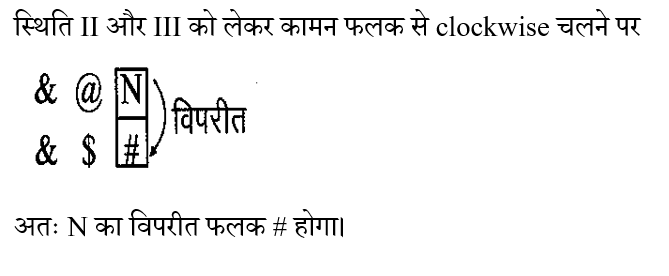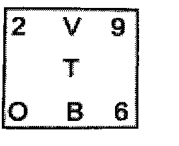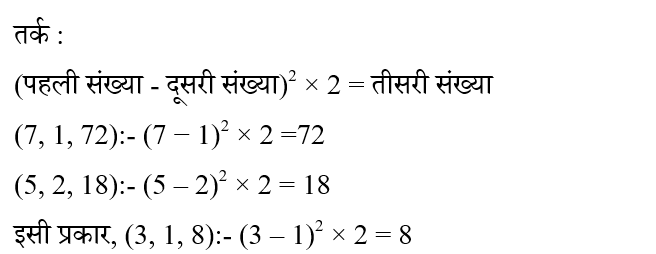Question 1:
Two different positions of the same dice are shown. If the number '6' is on the bottom (lower face), then what number will be on the top face?
एक ही पासे की दो भिन्न-भिन्न स्थितियों को दर्शाया गया है। यदि संख्या '6' नीचे (निचले फलक पर ) है, तो शीर्ष वाले फलक पर कौन-सी संख्या होगी ?
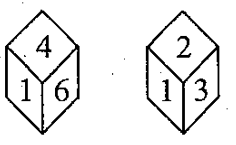
Question 2:
Select the correct combination of mathematical signs that when sequentially placed in place of * signs will balance the given equation.
गणितीय चिह्नों के उस सही संयोजन का चयन करें, जिन्हें * चिह्नों के स्थान पर क्रमिक रूप से रखे जाने पर दिया गया समीकरण संतुलित हो जाएगा।
65* 45 * 25 * 5* 35 * 60
Question 3:
In a code language 'TRAIN' is written as 'PKCTV' and 'MESH' is written as 'JUGO'. How will 'OMBRE' be written in the same language?
एक कूट भाषा में 'TRAIN' को 'PKCTV' लिखा जाता है और 'MESH' को 'JUGO' लिखा जाता है। उसी भाषा में 'OMBRE को कैसे लिखा जाएगा?
Question 4:
Three different positions of a dice are shown. Choose the symbol that will appear on the face opposite to the face with the letter 'N'.
एक पासे की तीन अलग-अलग स्थितियां दर्शाई गई हैं। वह प्रतीक चुनें जो 'N' अक्षर वाले फलक के विपरीत फलक पर आएंगा।

Question 5:
Find the next figure
अगली आकृति ज्ञात कीजिये
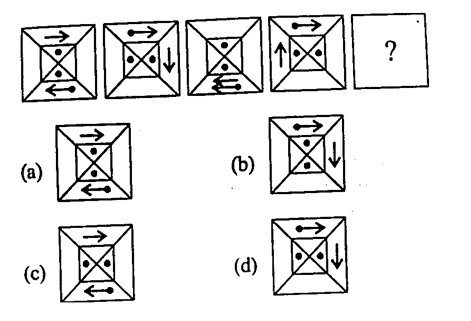
Question 6:
In a certain code language, 'LABOUR' is written as 'XZSECM' and 'GAINED' is written as 'JJRLCH'. How will 'EARNED' be written in the same language?
एक निश्चित कूट भाषा में, 'LABOUR' को 'XZSECM' लिखा जाता है और 'GAINED' को 'JJRLCH' लिखा जाता है। उसी भाषा में 'EARNED' को कैसे लिखा जाएगा?
Question 7:
Seven girls P, Q, R, S, T, U and V are sitting around a round table facing the centre of the table. Q sits third to the right of R. V sits third to the right of P. T sits next to the right of Q. S sits next to the left of R. U sits between R and P. Who sits between S and T?
सात लड़कियां P, Q, R, S, T, U और V एक गोल मेज के परितः मेज के केंद्र की ओर अभिमुख होकर बैठी हैं। Q, R के दाएं तीसरे स्थान पर बैठी है। V, P के दाएं तीसरे स्थान पर बैठी है। T, Q के दाएं बगल में बैठी है। S, R के बाएं बगल में बैठी है। R और P के बीच में U बैठी है। S और T के बीच में कौन है ?
Question 8:
How many triangles are there in the following figure?
निम्न आकृति में कितने त्रिभुज हैं ?

Question 9:
Directions: Select the figure that will replace the question mark (?) or come next in the following figure series.
दिशा निर्देश: उस आकृति का चयन करें जो प्रश्नवाचक चिह्न (?) की जगह लेगी या निम्नलिखित आकृति श्रृंखला में आगे आएगी।

Question 10:
Select the set in which the numbers are related to each other in the same way as the numbers of the following set are related to each other.
(Note: Mathematical operations should be performed on whole numbers without splitting the number into its constituent digits. For example mathematical operations such as addition/subtraction/multiplying etc. on the number 13 can be performed by - 13. Splitting 13 into 1 and 3 and then performing mathematical operations on 1 and 3 is not allowed)
उस समुच्चय का चयन कीजिए जिसन संख्याएँ एक-दूसरे से उसी प्रकार संबंधित हैं जिस प्रकार निम्नलिखित समुच्चय की संख्याएँ आपस में संबंधित हैं।
(नोट: संख्याओं को उसके घटक अंकों में विभाजित किए बिना, पूर्ण संख्याओं पर गणितीय संक्रियाएं की जानी चाहिए। उदाहरण के लिए 13 संख्या 13 पर गणितीय संक्रियाएं जैसे कि जोड़ना / घटाना / गुणा करना आदि को - 13 से किया जा सकता है। 13 को 1 और 3 में तोड़ना और फिर 1 और 3 पर गणितीय संक्रियाएँ करने की अनुमति नहीं है)
(7, 1, 72), (5, 2, 18)


